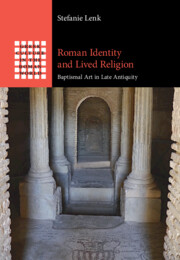Refine search
Actions for selected content:
5894 results in Classical art and architecture
One - Introduction
-
- Book:
- Religious Architecture and Roman Expansion
- Published online:
- 06 March 2025
- Print publication:
- 06 March 2025, pp 1-30
-
- Chapter
- Export citation
Five - Inventing History, Inventing Identity
-
- Book:
- Religious Architecture and Roman Expansion
- Published online:
- 06 March 2025
- Print publication:
- 06 March 2025, pp 174-202
-
- Chapter
- Export citation
Three - The Power of the Past
-
- Book:
- Religious Architecture and Roman Expansion
- Published online:
- 06 March 2025
- Print publication:
- 06 March 2025, pp 57-103
-
- Chapter
- Export citation
Copyright page
-
- Book:
- Religious Architecture and Roman Expansion
- Published online:
- 06 March 2025
- Print publication:
- 06 March 2025, pp iv-iv
-
- Chapter
- Export citation
Acknowledgments
-
- Book:
- Religious Architecture and Roman Expansion
- Published online:
- 06 March 2025
- Print publication:
- 06 March 2025, pp ix-xii
-
- Chapter
- Export citation
Introduction
-
- Book:
- Roman Identity and Lived Religion
- Published online:
- 08 February 2025
- Print publication:
- 20 February 2025, pp 1-24
-
- Chapter
- Export citation
Coda
-
- Book:
- Roman Identity and Lived Religion
- Published online:
- 08 February 2025
- Print publication:
- 20 February 2025, pp 194-200
-
- Chapter
- Export citation
Copyright page
-
- Book:
- Roman Identity and Lived Religion
- Published online:
- 08 February 2025
- Print publication:
- 20 February 2025, pp iv-iv
-
- Chapter
- Export citation
1 - The Absence of Christian Iconography and the Presence of Roman Cult and Culture in the Baptismal Complex of Cuicul, Numidia
-
- Book:
- Roman Identity and Lived Religion
- Published online:
- 08 February 2025
- Print publication:
- 20 February 2025, pp 25-78
-
- Chapter
- Export citation
Figures
-
- Book:
- Roman Identity and Lived Religion
- Published online:
- 08 February 2025
- Print publication:
- 20 February 2025, pp ix-xiv
-
- Chapter
- Export citation
3 - The Conversion of a Personification
-
- Book:
- Roman Identity and Lived Religion
- Published online:
- 08 February 2025
- Print publication:
- 20 February 2025, pp 155-193
-
- Chapter
- Export citation
Dedication
-
- Book:
- Roman Identity and Lived Religion
- Published online:
- 08 February 2025
- Print publication:
- 20 February 2025, pp v-vi
-
- Chapter
- Export citation
Acknowledgements
-
- Book:
- Roman Identity and Lived Religion
- Published online:
- 08 February 2025
- Print publication:
- 20 February 2025, pp xv-xvi
-
- Chapter
- Export citation
Preface
-
- Book:
- Roman Identity and Lived Religion
- Published online:
- 08 February 2025
- Print publication:
- 20 February 2025, pp xvii-xxix
-
- Chapter
- Export citation
Contents
-
- Book:
- Roman Identity and Lived Religion
- Published online:
- 08 February 2025
- Print publication:
- 20 February 2025, pp vii-viii
-
- Chapter
- Export citation
Index
-
- Book:
- Roman Identity and Lived Religion
- Published online:
- 08 February 2025
- Print publication:
- 20 February 2025, pp 245-248
-
- Chapter
- Export citation
2 - The Use of Non-Christian Imagery in Baptisteries
-
- Book:
- Roman Identity and Lived Religion
- Published online:
- 08 February 2025
- Print publication:
- 20 February 2025, pp 79-154
-
- Chapter
- Export citation
References
-
- Book:
- Roman Identity and Lived Religion
- Published online:
- 08 February 2025
- Print publication:
- 20 February 2025, pp 201-244
-
- Chapter
- Export citation
Abbreviations
-
- Book:
- Roman Identity and Lived Religion
- Published online:
- 08 February 2025
- Print publication:
- 20 February 2025, pp xxx-xxxii
-
- Chapter
- Export citation

Roman Identity and Lived Religion
- Baptismal Art in Late Antiquity
-
- Published online:
- 08 February 2025
- Print publication:
- 20 February 2025
